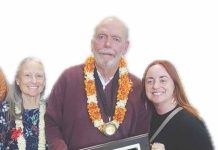With the burgeoning field of drone technology translating into exciting job opportunities, Grossmont College will offer a comprehensive training program that can transform amateurs into licensed commercial drone pilots in just three months.
Best of all, the training that can cost as much as $3,000 in the private sector is free to anyone who is at least 18 years old and a U.S. citizen, as required by the grant. The noncredit program is targeted to groups including veterans, Native Americans, military spouses, ex-offenders, women, high school students and the unemployed and underemployed. Drones are provided during the training.
Registration is now open for classes starting in March.
“Grossmont College has always been at the forefront of workforce training,” Grossmont College President Nabil Abu-Ghazaleh said. “We place great importance on recognizing hot new careers and ensuring that our students have the tools they need to forge ahead.”
Funded by a $6 million federal America’s Promise grant through the U.S. Department of Labor, the unmanned aerial systems (UAS) or drone technology program is comprised of two tracks: surveying and mapping, and cinematography.
The demand for drone pilots is skyrocketing, with predictions of a $250 billion industry worldwide this year. The commercial and military impact drones will have in the near future is significant, creating more than 100,000 new jobs by 2025, according to a 2013 report by the Association for Unmanned Vehicle Systems. In California, the number of jobs is expected to climb to 18,000, about a 400 percent increase since 2012.
Contract work for one-time jobs such as industrial inspections can pay from $30,000-$60,000 for a six-to-nine-month period, depending on experience and the nature of the mission, said Javier Ayala, dean of career and technical education and workforce development at Grossmont College. Starting wages for in-house drone operators range from $25-$35 an hour to $60-$100 an hour for fully trained pilots with three or more years of experience. Grossmont’s program prepares graduates for both contract and salaried jobs.
Jim Bonnardel, who teaches Grosssmont College’s drone surveying and mapping classes, said that in his class of 16 last year, several found jobs even before completing the program and three hung their own shingles as pilots for hire. One student is headed to South Africa for wildlife photography missions; another student who is a professional photographer has already sold drone images to Getty Images; and a third student, a former pilot in the Colombian Air Force, now flies a drone instead of a jet.
Bonnardel, who has been doing industrial drone training for years for corporations and companies, said he connected with Grossmont College because he was drawn to the idea of introducing a wide-open career field with a tremendous future to neophytes.
“I saw the need to fill the pilot jobs that are going unfilled and wanted to extend this amazing career to those who would not have gotten the opportunity,” he said. “The drone job market is touching more industries than many other technologies. From civil engineering to agriculture, to mapping soil conditions, plant health and more. Wildlife monitoring, infrared for roofing inspections, utility plant inspections, wind turbines…the possibilities just go on and on.”
Grossmont College’s program will first provide UAS Ground School and Federal Aviation Administration 107 certification classes that students take to become licensed commercial drone pilots. The FAA 107 certification school will provide students comprehensive classroom instruction to pass the FAA 107 written test which is administered free to students. Once students complete the ground school module and possess a drone pilot license, they can then go on to take UAS Surveying and Mapping or UAS Cinematography.
Pilots in the surveying and mapping course receive extensive flight time and students who complete the program will know how to do precision mapping missions and data collection for multiple industries and operations.
UAS cinematography covers both basic and advanced cinematography techniques. The theory and operations of both standard and advanced precision camera shots is combined with operational scenarios.
The UAS Surveying and Mapping track meets Monday and Wednesday from noon-4 p.m. or 4-8 p.m. March 4 to June 19. The UAS Cinematography track meets Tuesday and Thursdays from noon-4 or 4-8 p.m.
Register at https://tinyurl.com/APmapping2 or https://tinyurl.com/APcinema2.














